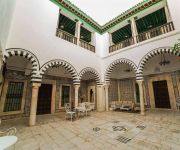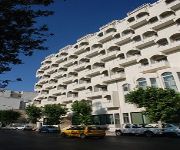Facts and Data
Webpages:
Official Unesco Page
Basis Data:
Unesco World heritage since: 1979
Size of heritage: 296 ha
- Buffer zone: 190 ha
Coordinates:
Longitude: 10,167°
Latitude: 36,817°
Summary
Under the Almohads and the Hafsids, from the 12th to the 16th century, Tunis was considered one of the greatest and wealthiest cities in the Islamic world. Some 700 monuments, including palaces, mosques, mausoleums, madrasas and fountains, testify to this remarkable past.
Location on Map
Show bigger map on Openstreetmap
Medina of Tunis: A Historic Gem in Tunisia
The Medina of Tunis, located in the capital city of Tunisia, is a UNESCO World Heritage site that showcases the rich history and cultural heritage of the region. With its labyrinthine streets, stunning architecture, and vibrant atmosphere, the Medina of Tunis is a testament to the city's past and a living testament to its present.
History
The Medina of Tunis dates back to the 9th century when it was established as the capital of the Aghlabid dynasty. Over the centuries, it grew and flourished under various rulers, including the Almohads and the Hafsids. The Medina became a hub of trade and culture, attracting merchants and scholars from across the Mediterranean.
During the Ottoman period in the 16th century, the Medina of Tunis underwent significant expansion and development. The city's walls were fortified, and numerous palaces, mosques, and madrasas (Islamic schools) were constructed. This period marked a golden age for Tunis, with the Medina becoming a center of Islamic learning and a thriving commercial hub.
However, the Medina of Tunis faced challenges in the 19th and 20th centuries. The city suffered from neglect and decay as the focus shifted to the modern parts of Tunis. Many historic buildings fell into disrepair, and the Medina's cultural significance was at risk of being lost.
Current State
Recognizing the importance of preserving this unique heritage, efforts have been made to restore and revitalize the Medina of Tunis. The Tunisian government, in collaboration with international organizations, has undertaken restoration projects to preserve the architectural and cultural heritage of the Medina.
Today, the Medina of Tunis is a vibrant and bustling neighborhood, with its narrow streets filled with shops, cafes, and traditional crafts. The architecture reflects a blend of Islamic, Ottoman, and Andalusian influences, with intricately carved facades, colorful tiles, and ornate courtyards.
One of the most iconic landmarks in the Medina is the Zitouna Mosque, which dates back to the 8th century. This grand mosque is a symbol of Tunisian identity and serves as a spiritual center for the local community. Visitors can explore its stunning interior and admire its beautiful minaret.
Another notable site within the Medina is the Dar Ben Abdallah Museum, housed in a restored 18th-century palace. The museum showcases traditional Tunisian crafts, including ceramics, textiles, and jewelry, providing visitors with a glimpse into the rich cultural heritage of the region.
The Medina of Tunis is not only a historic site but also a living neighborhood where locals continue to reside and carry on their traditions. The streets are filled with the aroma of spices, the sounds of merchants haggling, and the sight of artisans practicing their crafts.
Visiting the Medina of Tunis is like stepping back in time, immersing oneself in the vibrant history and culture of the city. It is a place where the past and present coexist, and where the spirit of Tunis lives on.
Hotels and places to stay
Sheraton Tunis Hotel
La Maison Blanche
Golden Tulip El Mechtel Tunis
Hôtel Le Consul
Dar Ben-Gacem
Majestic Hotel
Ambassadeurs Hôtel
Caribbean World Borj Cedria
Ariha
LE PACHA
Videos from the area
Videos provided by Youtube are under the copyright of their owners.

















